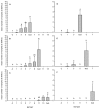Shoot feeding as a nutrient acquisition strategy in free-living psylloids
- PMID: 24194907
- PMCID: PMC3806811
- DOI: 10.1371/journal.pone.0077990
Shoot feeding as a nutrient acquisition strategy in free-living psylloids
Abstract
Shoot feeding by sucking insects is accepted as an adaptation to feeding where plant nutrients are most concentrated and/or of higher quality. Psylloids are an important hemipteran taxon, most of which are free-living and comprise many shoot feeding species, whose nutritional ecology has been largely ignored. I conducted a longitudinal study of Ctenarytaina eucalypti (Maskell) and C. bipartita Burckhardt et al. (Aphalaridae) feeding on eucalypts to document how within-plant (ontogenic) variation in nutritional quality, in particular of free amino acids, determines host suitability and hence the distribution and abundance of nymphs. Nymphs were most abundant within developing apical buds but were not more abundant on branchlets of greater vigour (indicated by rate of extension). Nymphs could be found up to two (C. bipartita) to three (C. eucalypti) alternate leaf pairs distant from apical buds but infrequently and in low numbers; they were never found on older, fully expanded leaves. The position of a leaf on a branchlet (indicative of age) determined its nutritional quality. Younger leaves had higher water contents, lower chlorophyll contents and differed in amino acid (essential and non-essential) composition compared to older leaves. The abundance of C. eucalypti nymphs on expanding leaves and in buds was positively correlated with the concentrations of methionine, valine and threonine in E. globulus leaves at the same or comparable position on a branchlet. The abundance of C. bipartita nymphs was positively correlated with foliar leucine concentrations. Shoot feeding by these two psyllids facilitates access to more concentrated, better quality plant nutrients but may not entirely explain the adaptive significance of their behaviour. The humid microclimate created by the architecture of the hosts' apical buds protects eggs and nymphs from desiccation and is suggested to have had a significant influence on the evolution of host utilisation strategies of psyllids within this genus.
Conflict of interest statement
Figures



Similar articles
-
Nutritional enhancement of leaves by a psyllid through senescence-like processes: insect manipulation or plant defence?Oecologia. 2014 Dec;176(4):1061-74. doi: 10.1007/s00442-014-3087-3. Epub 2014 Sep 21. Oecologia. 2014. PMID: 25241296 Free PMC article.
-
Not Led by the Nose: Volatiles from Undamaged Eucalyptus Hosts Do Not Influence Psyllid Orientation.Insects. 2018 Nov 17;9(4):166. doi: 10.3390/insects9040166. Insects. 2018. PMID: 30453652 Free PMC article.
-
Visual acuity trade-offs and microhabitat-driven adaptation of searching behaviour in psyllids (Hemiptera: Psylloidea: Aphalaridae).J Exp Biol. 2015 May 15;218(Pt 10):1564-71. doi: 10.1242/jeb.120808. Epub 2015 Mar 31. J Exp Biol. 2015. PMID: 25827835
-
[Occurrence of Ctenarytaina eucalypti (Maskell) (Hemiptera: Psyllidae) and its natural enemy Psyllaephagus pilosus Noyes (Hymenoptera: Encyrtidae) in Eucalyptus globulus in the state of Rio Grande do Sul, Brazil].Neotrop Entomol. 2010 Jul-Aug;39(4):671-3. doi: 10.1590/s1519-566x2010000400031. Neotrop Entomol. 2010. PMID: 20878008 Portuguese.
-
Ecological consequences of interactions between ants and honeydew-producing insects.Proc Biol Sci. 2007 Jan 22;274(1607):151-64. doi: 10.1098/rspb.2006.3701. Proc Biol Sci. 2007. PMID: 17148245 Free PMC article. Review.
Cited by
-
Symbionts in waiting: the dynamics of incipient endosymbiont complementation and replacement in minimal bacterial communities of psyllids.Microbiome. 2017 Jun 6;5(1):58. doi: 10.1186/s40168-017-0276-4. Microbiome. 2017. PMID: 28587661 Free PMC article.
-
Nutritional enhancement of leaves by a psyllid through senescence-like processes: insect manipulation or plant defence?Oecologia. 2014 Dec;176(4):1061-74. doi: 10.1007/s00442-014-3087-3. Epub 2014 Sep 21. Oecologia. 2014. PMID: 25241296 Free PMC article.
-
Physiological and oxidative stress response of carrot (Daucus carota L.) to jumping plant-louse Bactericera trigonica Hodkinson (Hemiptera: Psylloidea) infestation.BMC Plant Biol. 2024 Apr 4;24(1):243. doi: 10.1186/s12870-024-04946-4. BMC Plant Biol. 2024. PMID: 38575896 Free PMC article.
References
-
- Maelzer DA (1977) The biology and main causes of changes in numbers of the Rose aphid, Macrosiphum rosae (L.), on cultivated roses in South Australia. Aust J Zool 25: 269-284..
-
- Kidd NAC (1985) The role of the host plant in the population dynamics of the large pine aphid, Cinara pinea . Oikos 44: 114-122. doi:10.2307/3544051. - DOI
-
- Price PW (2003) Macroevolutionary theory on macroecological patterns. Cambridge: Cambridge University Press. 291 pp.
-
- White TCR (2009) Plant vigour versus plant stress: a false dichotomy. Oikos 118: 807-808. doi:10.1111/j.1600-0706.2009.17495.x. - DOI
-
- Steinbauer MJ, Clarke AR, Paterson SC (1998) Changes in eucalypt architecture and the foraging behaviour and development of Amorbus obscuricornis (Hemiptera: Coreidae). Bull Entomol Res 88: 641-651. doi:10.1017/S0007485300054316. - DOI
Publication types
MeSH terms
Substances
LinkOut - more resources
Full Text Sources
Other Literature Sources

